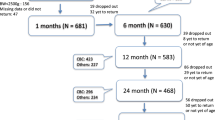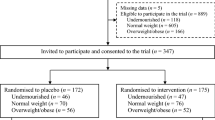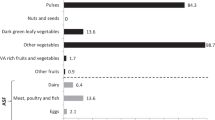Abstract
Objective:
To investigate the associations of iron status at 6 years of age with dietary and other factors.
Design:
In a cross-sectional study, children's dietary intakes (3-day weighed food record) were recorded, body size was measured and blood samples were taken near their sixth birthday.
Subjects:
A sample of 188 children, from two previous studies (cohorts 1 and 2), was contacted, and 139 (74%) agreed to participate.
Results:
Multiple regression analyses with dietary and other factors showed that meat and fish consumption, multivitamin/mineral supplement intake (both positively) and cow's milk product consumption (negatively) were associated with log serum ferritin (SF) (adjusted R2=0.125; P=0.028; n=129), and juices and residence (rural>urban) with haemoglobin (Hb) (adjusted R2=0.085; P=0.034; n=127). Of 21 multivitamin/mineral consumers, none had depleted iron stores compared to 21 iron-depleted of 108 non-consumers (P=0.024). Children living in rural areas (<10 000 inhabitants) (n=33) had higher mean corpuscular volume (MCV) (83.3±2.3 fl) than those living in urban areas (>10 000 inhabitants) (82.1±3.2 fl; n=103) (P=0.048). Multiple regression analyses with dietary and other factors and growth showed in cohort 1 that residence (rural>urban), weight gain 0–1years (negatively), and meat and fish intake (positively) were associated with Hb (adjusted R2=0.323; P=0.030; n=51), meat and fish (positively) with both log SF (adjusted R2=0.069; P=0.035; n=52) and MCV (adjusted R2=0.064; P=0.035; n=52), and in cohort 2 cow's milk product consumption (negatively) was associated with log SF (adjusted R2=0.119; P=0.017; n=41) and residence (rural>urban) with MCV (adjusted R2=0.102; P=0.025; n=41).
Conclusions:
Consumption of meat and fish and possibly also juices, as well as multivitamin/mineral intake might affect iron status in 6-year-old children positively, whereas cow's milk product consumption might affect iron status negatively. Slower growth in the first year of life and rural residence are positively related to iron status of 6-year-olds.
Sponsorship:
The Icelandic Research Council.
This is a preview of subscription content, access via your institution
Access options
Subscribe to this journal
Receive 12 print issues and online access
$259.00 per year
only $21.58 per issue
Buy this article
- Purchase on Springer Link
- Instant access to full article PDF
Prices may be subject to local taxes which are calculated during checkout
Similar content being viewed by others

References
Domellof M, Hernell O (2002). Iron-deficiency anaemia during the first two years of life. Scand J Nutr 46, 20–30.
Duggan MB, Steel G, Elwys G, Harbottle L, Noble C (1991). Iron status, energy intake, and nutritional status of healthy young Asian children. Arch Dis Child 66, 1386–1389.
Engelmann MD, Davidsson L, Sandstrom B, Walczyk T, Hurrell RF, Michaelsen KF (1998b). The influence of meat on nonheme iron absorption in infants. Pediatr Res 43, 768–773.
Engelmann MD, Sandstrom B, Michaelsen KF (1998a). Meat intake and iron status in late infancy: an intervention study. J Pediatr Gastroenterol Nutr 26, 26–33.
Fairweather-Tait SJ, Fox T, Wharf SG, Eagles J (1995). The bioavailability of iron in different weaning foods and the enhancing effect of a fruit drink containing ascorbic acid. Pediatr Res 37, 389–394.
Freeman VE, Mulder J, van’t Hof MA, Hoey HM, Gibney MJ (1998). A longitudinal study of iron status in children at 12, 24 and 36 months. Public Health Nutr 1, 93–100.
Garcia-Casal MN, Layrisse M, Solano L, Baron MA, Arguello F, Llovera D et al. (1998). Vitamin A and beta-carotene can improve nonheme iron absorption from rice, wheat and corn by humans. J Nutr 128, 646–650.
Gibson SA (1999). Iron intake and iron status of preschool children: associations with breakfast cereals, vitamin C and meat. Public Health Nutr 2, 521–528.
Gill DG, Vincent S, Segal DS (1997). Follow-on formula in the prevention of iron deficiency: a multicentre study. Acta Paediatr 86, 683–689.
Gunnarsson BS, Thorsdottir I, Palsson G (2004). Iron status in 2-year-old Icelandic children and associations with dietary intake and growth. Eur J Clin Nutr 58, 901–906.
Gunnarsson BS, Thorsdottir I, Palsson G (2005). Iron status in 6-y-old children: associations with growth and earlier iron status. Eur J Clin Nutr 59, 761–767.
Gunnarsson BS, Thorsdottir I, Palsson G, Gretarsson SJ (2006). Iron status at 1 and 6 years vs developmental scores at 6 years in a well-nourished affluent population. Acta Paediatr, in press.
Hallberg L, Brune M, Rossander-Hulthen L (1987). Is there a physiological role of vitamin C in iron absorption? Ann N Y Acad Sci 498, 324–332.
Karr M, Alperstein G, Causer J, Mira M, Lammi A, Fett MJ (1996). Iron status and anaemia in preschool children in Sydney. Aust N Z J Public Health 20, 618–622.
Lawson MS, Thomas M, Hardiman A (1998). Iron status of Asian children aged 2 years living in England. Arch Dis Child 78, 420–426.
Lind T, Hernell O, Lonnerdal B, Stenlund H, Domellof M, Persson L-A (2004). Dietary iron intake is positively associated with haemoglobin concentration during infancy but not during second year of life. J Nutr 134, 1064–1070.
Looker AC, Sempos CT, Johnson CL, Yetley EA (1987). Comparison of dietary intakes and iron status of vitamin-mineral supplement users and nonusers, aged 1-19 years. Am J Clin Nutr 46, 665–672.
Michaelsen KF, Milman N, Samuelson G (1995). A longitudinal study of iron status in healthy Danish infants:effects of early iron status, growth velocity and dietary factors. Acta Paediatr 84, 1035–1044.
Mills AF (1990). Surveillance for anaemia: risk factors in patterns of milk intake. Arch Dis Child 65, 428–431.
Nordic Expert Group for Nutritional Recommendations (2004). Nordic Nutrition Recommendations 2004. Nordic Council of Ministers, Nord, 2004, p 13, ISBN 92 893 1062 6.
Ramakrishnan U, Yip R (2002). Experiences and challenges in industrialized countries: control of iron deficiency in industrialized countries. J Nutr 132, 820S–824S.
Sharp P (2004). The molecular basis of copper and iron interactions. Proc Nutr Soc 63, 563–569.
Thane CW, Bates CJ, Prentice A (2003). Risk factors for low iron intake and poor iron status in a national sample of British young people aged 4–18 years. Public Health Nutr 6, 485–496.
Thane CW, Walmsley CM, Bates CJ, Prentice A, Cole TJ (2000). Risk factors for poor iron status in British toddlers: further analysis of data from the National Diet and Nutrition Survey of children aged 1.5–4.5 years. Public Health Nutr 3, 433–440.
Thorsdottir I, Gunnarsson BS, Atladottir H, Michaelsen KF, Palsson G (2003). Iron status at 12 months of age – effects of body size, growth and diet in a population with high birth weight. Eur J Clin Nutr 57, 505–513.
Walczyk T, Davidsson L, Rossander-Hulthen L, Hallberg L, Hurrell RF (2003). No enhancing effect of vitamin A on iron absorption in humans. Am J Clin Nutr 77, 144–149.
Walter T, Dallman PR, Pizarro F, Velozo L, Pena G, Bartholmey SJ et al. (1993). Effectiveness of iron-fortified infant cereal in prevention of iron deficiency anemia. Pediatrics 91, 976–982.
WHO (2001). Iron deficiency anaemia. Assessment, prevention and control. A guide for programme managers. WHO/NHD/01/.3 WHO: Geneva.
Acknowledgements
We thank the staff at the laboratories of Landspitali – University Hospital in Reykjavik, Iceland.
Author information
Authors and Affiliations
Corresponding author
Additional information
Guarantor: BS Gunnarsson.
Contributors: BSG is a nutritionist. BSG worked on the data collection, calculations and statistical analysis and the writing of the paper. IT is a professor of human nutrition. IT is the project leader; she designed the study and participated actively in data collection, interpretation of the results and writing of the paper. GP is a paediatrician; he participated in the project planning and took care of all blood sampling.
Rights and permissions
About this article
Cite this article
Gunnarsson, B., Thorsdottir, I. & Palsson, G. Associations of iron status with dietary and other factors in 6-year-old children. Eur J Clin Nutr 61, 398–403 (2007). https://doi.org/10.1038/sj.ejcn.1602529
Received:
Revised:
Accepted:
Published:
Issue Date:
DOI: https://doi.org/10.1038/sj.ejcn.1602529


